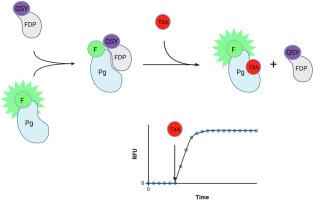Development of an assay to quantify tranexamic acid levels in plasma
IF 2.6
4区 生物学
Q2 BIOCHEMICAL RESEARCH METHODS
引用次数: 0
Abstract
Dysregulations of blood clot breakdown (fibrinolysis) during vascular trauma can lead to excessive blood loss. Tranexamic acid (TXA) is an inhibitor of fibrinolysis that works by blocking the interaction between plasminogen and fibrin degradation products (FDPs) – a key step in fibrinolysis. Despite the widespread usage, there are no tests available in a clinical setting to monitor TXA levels. We developed a fluorescence resonance energy transfer (FRET)-based assay to quantify TXA concentrations in plasma by using 1) fluorescently labeled plasminogen, and 2) FDPs labeled with a fluorescence quencher. Once plasminogen binds the FDPs, the fluorescent signal is quenched. TXA causes plasminogen to dissociate from the FDPs, thus increasing fluorescence signal in a dose-dependent manner. The dose response was sensitive between 1 and 100 μM (0.16 and 15.7 mg/L). The intraassay and interassay variabilities were determined to be 5.7 % and 3.0 %, respectively. Limit of detection was estimated to be 0.28 μM (0.044 mg/L). When tested for measuring known levels of TXA added to plasma samples, the ratio between measured and expected TXA concentration was 1.0151. Our study demonstrates a novel assay that can rapidly quantify TXA concentrations in plasma samples, thus demonstrating its potential as an in-hospital tool.

开发一种测定血浆中氨甲环酸水平的方法。
血管创伤期间血凝块分解(纤溶)失调会导致失血过多。氨甲环酸(TXA)是一种纤维蛋白溶解抑制剂,通过阻断纤溶过程中的关键步骤--纤溶酶原与纤维蛋白降解产物(FDPs)之间的相互作用而发挥作用。尽管TXA被广泛使用,但目前临床上还没有可用来监测TXA水平的检测方法。我们开发了一种基于荧光共振能量转移(FRET)的检测方法,通过使用 1)荧光标记的纤溶酶原和 2)荧光淬灭剂标记的 FDPs 来量化血浆中的 TXA 浓度。一旦纤溶酶原与 FDPs 结合,荧光信号就会被淬灭。TXA 会导致纤溶酶原与 FDPs 分离,从而以剂量依赖的方式增加荧光信号。剂量反应灵敏度在 1 到 100 μM(0.16 到 15.7 mg/L)之间。测定内和测定间变异性分别为 5.7 % 和 3.0 %。检测限估计为 0.28 μM(0.044 mg/L)。当测试测量血浆样本中添加的已知 TXA 水平时,测量值与预期 TXA 浓度的比值为 1.0151。我们的研究展示了一种可快速定量血浆样本中 TXA 浓度的新型检测方法,从而证明了其作为院内工具的潜力。
本文章由计算机程序翻译,如有差异,请以英文原文为准。
求助全文
约1分钟内获得全文
求助全文
来源期刊

Analytical biochemistry
生物-分析化学
CiteScore
5.70
自引率
0.00%
发文量
283
审稿时长
44 days
期刊介绍:
The journal''s title Analytical Biochemistry: Methods in the Biological Sciences declares its broad scope: methods for the basic biological sciences that include biochemistry, molecular genetics, cell biology, proteomics, immunology, bioinformatics and wherever the frontiers of research take the field.
The emphasis is on methods from the strictly analytical to the more preparative that would include novel approaches to protein purification as well as improvements in cell and organ culture. The actual techniques are equally inclusive ranging from aptamers to zymology.
The journal has been particularly active in:
-Analytical techniques for biological molecules-
Aptamer selection and utilization-
Biosensors-
Chromatography-
Cloning, sequencing and mutagenesis-
Electrochemical methods-
Electrophoresis-
Enzyme characterization methods-
Immunological approaches-
Mass spectrometry of proteins and nucleic acids-
Metabolomics-
Nano level techniques-
Optical spectroscopy in all its forms.
The journal is reluctant to include most drug and strictly clinical studies as there are more suitable publication platforms for these types of papers.
 求助内容:
求助内容: 应助结果提醒方式:
应助结果提醒方式:


